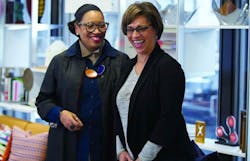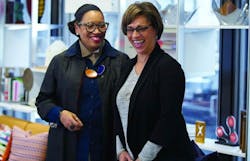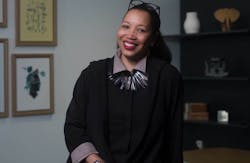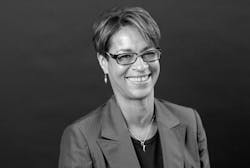IIDA’s Leadership Discusses the Importance of Diversity in the Design Industry
Note: This article was originally featured in interiors+sources’ February issue.
In a 2016 article titled, “Is Design Lacking Diversity?” interiors+sources examined in greater detail the results of an industry roundtable hosted by the International Interior Design Association (IIDA) that addressed the importance of gender, equity, and multidisciplinary thinking in design practices.
The report revealed that there is significant misrepresentation of women within higher positions in interior design firms, with only 25% of firm leaders being female. Yet 60% of the 87,000 industry practitioners in the U.S. are women.
A bigger picture of the lack of diversity is reflected in the figures from a 2017 report from the Bureau of Labor Statistics: 84.6% of architects are white, 24.4% are women, and only 5.8% are of African American origin.
Given the universal nature of design, these statistics are surprising, if not disconcerting. In an industry as creative and inclusive as ours, how can one explain these disparities? More importantly, what do we want our industry to look like in the future, and how do we get there?
To answer these questions, we asked two highly respected and successful women of color who have made tremendous impacts in the industry during their careers. These pioneering women who are leading the charge at IIDA hardly need any introduction, but they’ve certainly earned it.
Gabrielle Bullock is the current national President of IIDA and oversees Perkins+Will’s Diversity, Inclusion, and Engagement program, which works to support and strengthen a firmwide culture that embraces a diversity of people, colors, creeds, credos, talents, thoughts, and ideas.
Bullock has been a key player in Perkins+Will’s success for nearly 30 years, becoming the first African-American and first woman to rise to the position of Managing Director of the firm’s Los Angeles office.
Bullock graduated in 1984 from the Rhode Island School of Design with degrees in fine arts and architecture, becoming the second African-American woman in history to earn an architecture degree from RISD. In 2014, she was elected by her peers as a Fellow of the American Institute of Architects (AIA), and now serves on the AIA’s Equity in Architecture Commission.
Cheryl Durst has spurred progress, driven change, and encouraged the expansion of the interior design industry as the Executive Vice President and Chief Executive Officer of IIDA for the past 20 years. In 1997, Cheryl joined IIDA as the Senior Director of Education and Professional Development and was promoted to Executive Vice President and Chief Executive Officer in 1998, she began the task of rebuilding and redefining the organization, which was teetering on the brink of bankruptcy and closure due to organizational mismanagement.
[Related: IIDA: Increasing and Challenging Diversity at University Level Needed]
Through her efforts, she revived the association and repositioned it as a profitable enterprise, integral to the interior design community and dedicated to furthering the profession of interior design. She is committed to achieving broad recognition for the value of design and its significant role in society through both functionality and engagement in every day work spaces and the built environment.
Following is a recent conversation interiors+sources had [separately] with Bullock and Durst about their respective journeys in the world of design, the challenges they faced as minorities, and their hopes for the future of the industry.
i+s: What were some of the challenges you faced during your career in design, particularly working as a minority in the industry? How did those experiences shape who you are today?
Cheryl Durst: The conversation about diversity has always been something kind of alive and well in the organization and, quite honestly, my first difficult experience with IIDA came when it was announced that I was going to be CEO.
There was going to be a big public announcement [at NeoCon], and my family was actually threatened. An anonymous letter was sent to IIDA headquarters, and it said that if this ‘N-word’ becomes the CEO, then there’s a price to be paid. And the writer of the letter purported to be a member of the association and said that never in the history of this organization would anybody have ever thought that, again, an ‘N-word’ would run this organization.
Obviously, it was debilitating. Rather than be fearful, however, it fueled my desire to expand diversity, whether it was amongst my staff, definitely amongst the membership, but clearly the face of design [as well].
So, architects like Gabrielle, like Phil Freelon, everyone knows what it’s like to be the first or only person of color in the room, and your responsibility as a person of color is probably amplified. Because there is this sense that we’re representing people in this profession who often don’t have a voice. So, that’s always been something that I have seen as my responsibility leading a design organization—to be the best possible example of a professional and show that it is possible. We are out there; we are in this profession.
Gabrielle Bullock: When you’re the only one in the room, and you don’t see anybody that looks like you, you can either try and disappear or make yourself more visible and better. Right? I was driven by excellence. I never allowed my race or my gender to be a problem. If someone had a problem with it, I made it their problem, not mine.
So, I think it was my attitude of success, and I’m going to quote Paul Williams, who is one of the first black architects, and he said that ‘Excellence is the best deterrent to racism.’ And so that’s been my approach to racism, to bias, to stereotype, whatever. I think my attitude pretty much steered folks away from being overtly negative towards my race or gender.
I think my biggest challenge was trying to understand this profession that I embarked on, and I thought it was going to be pretty easy language. It was so esoteric, and I was like, ‘You guys probably don’t want me to understand what you’re talking about.’ But I loved it so much, I didn’t have a plan B. I only had a plan A.
GB: When you think about it, it’s baffling that such a creative profession is not as diverse as it should be, and that if we believe that the more diverse you are the more creative and successful you’ll be, you’d think we’d have figured this out. But I think it goes back to the start of the profession; it was an elite profession that only the wealthy could afford, in most cases, and who could go to college. Well, they weren’t people of color. So, I think historically it’s set up, the imbalance that it is, it’s going to take a long time to reverse that.
(Photo: Cheryl Durst and Gabrielle Bullock. Credit: Ryan McDonald)
CD: I think in a lot of ways in the profession of design and the profession of architecture, sometimes it’s about access and exposure. For a lot of people of color, the commonly held belief—and I’ll even take the people of color out of there—for a lot of people, the profession and practice of design is seen as a luxury and not a necessity.
Design isn’t always that first go-to profession. [It] isn’t regarded as a profession where A, you’re making money, or B, a profession that offers necessity to humanity. We know the opposite is true. You can earn a living as a designer and an architect and, in fact, design is obviously very much tied to the human experience. So, as an industry we need to do a better job in talking about who we are and what we do.
i+s: When did you become involved with IIDA, and what have you valued most about your experience with the association?
CD: Over the decades that I’ve been with the association, my opportunity to not sit in this office and [instead] be in San Francisco or Kansas City or Boston, and to be an active part of those communities, and working with our chapters to kind of move their own grassroots efforts forward, it’s been incredible to see this shift from my early days at IIDA.
[In the past] our members were completely focused on what was right in front of them, and maybe it was conversations about legislation or conversations about brokers or whatever. But it’s been amazing in the last few decades to see our members expand into these realms where they are having larger conversations with other stakeholders. So, just the expansion of the realm that our members are operating in, it’s been really gratifying for me to be a part of those conversations.
GB: In 2016, I was asked to present [Perkins+Will’s] diversity program at the [IIDA] industry roundtable and following that, I was asked to join the board. And it was a goal I think of Cheryl’s and the board’s at the time to advance diversity within the profession.
So I joined the board, and my main goal as president is to try and bridge that gap and to continue to elevate [the profession], because I think IIDA is an excellent organization in elevating and celebrating and being proactive in addressing the issues that face the interior design industry, and so I want to be a part of it as much as I can.
i+s: What do you see as being some of the most pressing issues facing the industry today?
GB: I think the whole generational issue that we face and how that either influences or is impacted by interior design and the spaces that we design is a big challenge. And a big topic at the IIDA roundtable this past weekend—and I think it’s bigger than anybody really thought—is how interior designers today, where they work, how they work, why do they work where they work, is a completely different approach [than in the past]. So, I think that’s one of the bigger issues that we face: the generational issue, and the fact that there are three or four generations in the workplace at the same time.
CD: For the last two years we’ve seen many of the best business books out there have all invoked in some way, shape, or form the term ‘design thinking’ and, reminding the public, reminding clients, reminding consumers that design is a profession, not just an avocation—and it’s not a fad.
In some aspects, design thinking has become a phrase that people now will use when they want to market [themselves]. And those are offered by people who are not professional designers. So, the conversation around professionalism, which was as vital 25 years ago as it is now, it may have shifted and changed, but it is still vital because professionalism and design should be said in the same sentence. They’re not two separate thoughts.
i+s: This year marks the 25th anniversary of IIDA. What does this milestone mean to the Association?
CD: I think we’re at a place where IIDA can be a credible commentator on the state of design, and to that end, in preparation to get to this point of our 25th year, and something that we hadn’t previously done, is a compensation survey. And so that is all about IIDA’s ability to amass a critical amount of data and information about our profession and creating this [industry] profile. Then, hand-in-hand with that is this product, this tool that we call the Index, and that is all about the health of the commercial interior design industry.
Ten years ago, we weren’t in that position to be able to have enough data and metrics to be able to comment credibly on the scope and reach and worth and value [of the industry]. It’s not sexy, but it’s important.
i+s: What are your hopes for the future of the design industry?
CD: Well, I’m hopeful about all aspects of the profession. I’m hopeful in that a new generation of designers that are coming into the profession, being very proud of who they are; they’re not apologists, and they proudly want to call themselves interior designers. They’re not hiding behind any other names. That’s a big change.
From an external standpoint, I think in the marketplace, there is a greater appreciation for what design is and what design can do. So, I love this mode or moment that we’re in from a societal standpoint where people are understanding that design requires rigor, and it requires thought, and it requires expertise.
I think it’s up to all of us—whether we run organizations or we’re practitioners or we’re at firms—to continue to reinforce the idea that design is this life-affirming practice that is meaningful, and it is art, and it is science, and that there’s this incredible power behind what design is and what designers can do.
GB: I see a cultural shift. I don’t think it’s going to happen overnight. I think it’s a journey, but if all the activity that I’ve seen over the last three to four years continues, I think we could evolve the design profession to be more representative of our society and what we need as a society to live, work, and play more efficiently and more comfortably or creatively, etc.
I think that it’s absolutely critical for us to address many of these things to remain relevant, and the biggest challenge in that is to get rid of the fear of change. So, I’m hopeful because I don't have a plan B, remember?
Read Next: Next-Generation Designers Offer Insight into Future of Design
About the Author
Robert Nieminen
Chief Content Director
Chief Content Director, Architectural Products, BUILDINGS, and interiors+sources
Robert Nieminen is the Chief Content Director of three leading B2B publications serving the commercial architecture and design industries: Architectural Products, BUILDINGS, and interiors+sources. With a career rooted in editorial excellence and a passion for storytelling, Robert oversees a diverse content portfolio that spans award-winning feature articles, strategic podcast programming, and digital media initiatives aimed at empowering design professionals, facility managers, and commercial building stakeholders.
He is the host of the I Hear Design podcast and curates the Smart Buildings Technology Report, bringing thought leadership to the forefront of innovation in built environments. Robert leads editorial and creative direction for multiple industry award programs—including the Elev8 Design Awards and Product Innovation Awards—and is a recognized voice in sustainability, smart technology integration, and forward-thinking design.
Known for his sharp editorial vision and data-informed strategies, Robert focuses on audience growth, engagement, and content monetization, leveraging AI tools and SEO-driven insights to future-proof B2B publishing.





